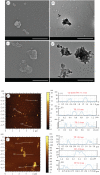Adsorption and release on three-dimensional graphene oxide network structures
- PMID: 34084539
- PMCID: PMC8150017
- DOI: 10.1098/rsos.201585
Adsorption and release on three-dimensional graphene oxide network structures
Abstract
In this study, three-dimensional network architectures are constructed using nano-sized graphene oxide (nGO) as the building block. The cross-linking reaction of nGO is conducted in sub-micrometre water droplets in an emulsion system to control the size of the networks by restricting the reaction space. Two types of three-dimensional GO networks with different cross-linking lengths were constructed, and their methyl orange adsorption and release behaviours were investigated under external stimuli, such as thermal treatment, ultrasonic wave treatment and near-infrared light irradiation.
Keywords: drug delivery; graphene oxide; network structure.
© 2021 The Authors.
Figures






References
-
- Pumera M. 2011. Graphene in biosensing. Mater. Today 14, 308-315. (10.1016/S1369-7021(11)70160-2) - DOI
Associated data
LinkOut - more resources
Full Text Sources

